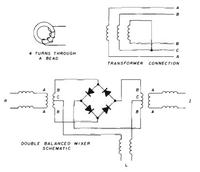neazoi
Advanced Member level 6

Hello,
I have seen this double balanced mixer design, which uses ft50-61 for the T1.
I would like to improve the thermal stability of it by using T50-6.
Using toroids calculator I found that 7 turns on a FT50-61 are 3.38uH.
On he other hand 3.38uH on a T50-6 will require 29 turns.
I have two things that worry me in substituting these transformers:
1. I calculated the inductances assumming a single wire. T1 is trifilar. Will the inductances be the same for each wire?
2. Should I worry about achieving the same inductance, or should I just achieve the same turns ratio instead? I.e is is right what I am doing here?
I have seen this double balanced mixer design, which uses ft50-61 for the T1.
I would like to improve the thermal stability of it by using T50-6.
Using toroids calculator I found that 7 turns on a FT50-61 are 3.38uH.
On he other hand 3.38uH on a T50-6 will require 29 turns.
I have two things that worry me in substituting these transformers:
1. I calculated the inductances assumming a single wire. T1 is trifilar. Will the inductances be the same for each wire?
2. Should I worry about achieving the same inductance, or should I just achieve the same turns ratio instead? I.e is is right what I am doing here?



